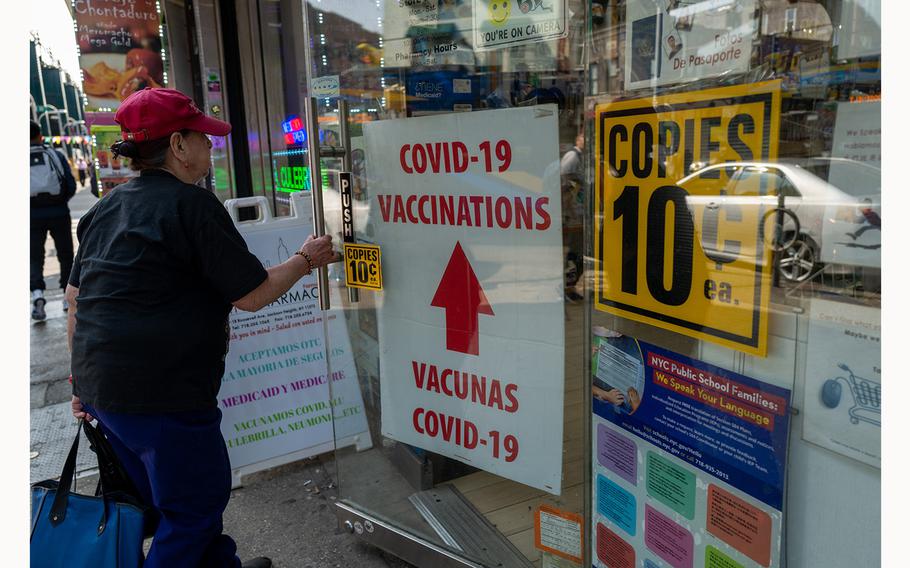
A pharmacy advertises COVID-19 vaccines in a window in the Queens borough of New York City on May 11, 2023. (Spencer Platt/Getty Images/TNS)
(Tribune News Service) — COVID cases continue to rise and fall in Northeastern Oklahoma, and new strains keep popping up as time goes by.
The beginning of the COVID pandemic for U.S. citizens was March 13, 2020, when former President Donald J. Trump declared a nationwide emergency and issued an additional travel ban on non-U.S. citizens traveling from 26 European countries.
But the Center for Disease Control and Prevention’s timeline of the pandemic starts Dec. 12, 2019, when patients in the city of Wuhan, China, began having symptoms of a pneumonia-like illness that didn’t respond to standard treatments.
Since that time, announcements of mutations of the virus have kept citizens on edge, and a continued dialogue had on the best methods of containment.
“SARS-CoV-2, the virus that causes COVID-19, is constantly changing and accumulating mutations in its genetic code over time,” states the CDC website. “New variants of SARS-CoV-2 are expected to continue to emerge. Some variants will emerge and disappear, while others will emerge and continue to spread and may replace previous variants.”
Public Information Officer Erica Rankin-Rileym with the Oklahoma State Department of Health, said the agency has seen an uptick in positive cases lately.
“COVID-19 Data Dashboard — oklahoma.gov — Our Viral View dashboard, tracks different metrics when it comes to monitoring COVID-19 in Oklahoma,” Rankin-Riley said.
On the chart for the week of June 22, the positivity rate for Oklahoma was 8.4%, up from 2.9% the week of April 27, but down from the week of Feb. 17, which came in at 10.2%.
Of those reported cases in 2024 in Oklahoma, the variants included Delta, Omicron EG.5 and Omicron B.A. 2. In May, the variant was Omicron BA.2, according to the ODH website.
Across the U.S., at the end of March, the KP.2 variant was causing about 4% of infections, according to the CDC, while its parental strain, JN.1, was causing over 50% of infections at that time. As of early May, KP.2 has made up about 28% of infections, overtaking JN.1 as the dominant variant, states the CDC site.
Rankin-Riley said most people with COVID-19 are mildly ill and can recover at home, treated with over-the-counter medicines, like acetaminophen or ibuprofen.
“There are also antiviral medications like Paxlovid, which can be prescribed by a health care provider for individuals who may be at a greater risk of getting sick or progressing to severe illness,” Rankin-Riley said. “These treatments should be started as soon as possible once symptoms begin, since they are most effective if started within five to seven days after onset of illness.”
Stacy Pratt, a former Tahlequah resident, is a magazine writer and musician living in Tulsa. She recently explained that she first contracted COVID in February 2022, and then again in December 2022.
“Most days I am good, but all of a sudden, I can’t read a calendar or schedule things,” Pratt said. “I knew it wasn’t dementia and I started researching.”
She visited her doctor a month after her first illness because of extreme fatigue and fevers when trying to do any physical or mental work.
“[My doctor] said it lasted for six months. We would call it ‘long COVID,’ but otherwise, it just took a while to get well,” Pratt said.
Her health had not improved from her first case in April when she again contracted the virus in December.
“The second round restarted the clock, recovery-wise,” Pratt said. “I still get PEM — Post-Exertional Malaise — if I get too worn out, and do something as negligible as writing an article, while sometimes I can play a gig with my band, crash for a few days, then be fine.”
She got the virus even though she was up to date on the vaccines. But she believes it would have been much worse if she had not taken the shots.
“But it is still alarming to be this affected so long after I was ill,” Pratt said. “It has changed my life.”
Calls to local health care providers about local COVID numbers were not returned by press time, which was a day earlier than normal due to the Fourth of July holiday.
(c)2024 the Tahlequah Daily Press (Tahlequah, Okla.)
Visit the Tahlequah Daily Press
Distributed by Tribune Content Agency, LLC.